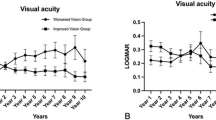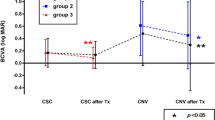Abstract
Purpose
To investigate whether patients with central serous chorioretinopathy (CSC) have increased risk of developing glaucoma.
Methods
Patients diagnosed with CSC between 1 January 2008 and 31 December 2018 were included in this study using data from the Taiwanese National Health Insurance Research Database (NHIRD). The CSC cohort was matched with a non-CSC cohort using the propensity score matching method, based on sex, age (in 10-year intervals), index date year, comorbidities, and steroid use, resulting in equal numbers of patients in both cohorts. Patients were followed up until 31 December 2019 or until they were withdrawn from the NHIRD. The incidence of glaucoma was compared between the two cohorts using the Cox regression model, and the risk of developing glaucoma was estimated using the Kaplan–Meier method.
Results
After adjusting for sex, age, comorbidities, and steroid use, the CSC cohort showed a significantly higher risk of developing glaucoma compared to those without CSC (adjusted HR = 3.99; 95% CI = 3.44–4.62). The cumulative incidence of glaucoma in the CSC cohort was also significantly higher than in the non-CSC cohort (log-rank test, p < 0.001). Among the glaucoma subtypes, normal tension glaucoma had the highest risk (adjusted HR = 5.79; 95% CI = 3.41–9.85), followed by primary open-angle glaucoma (adjusted HR = 2.77; 95% CI = 2.12–3.62).
Conclusions
In conclusion, our study shows that CSC patients are at a higher risk of developing glaucoma, especially NTG. Awareness and regular glaucoma screenings are essential for patients with CSC.

Similar content being viewed by others
References
Daruich A, Matet A, Dirani A, Bousquet E, Zhao M, Farman N, Jaisser F, Behar-Cohen F (2015) Central serous chorioretinopathy: Recent findings and new physiopathology hypothesis. Prog Retin Eye Res 48:82–118. https://doi.org/10.1016/j.preteyeres.2015.05.003
Chan WM, Lim TH, Pece A, Silva R, Yoshimura N (2010) Verteporfin PDT for non-standard indications–a review of current literature. Graefes Arch Clin Exp Ophthalmol 248:613–626. https://doi.org/10.1007/s00417-010-1307-z
Yannuzzi LA (1987) Type-A behavior and central serous chorioretinopathy. Retina 7:111–131. https://doi.org/10.1097/00006982-198700720-00009
Tsai DC, Chen SJ, Huang CC, Chou P, Chung CM, Huang PH, Lin SJ, Chen JW, Chen TJ, Leu HB, Chan WL (2013) Epidemiology of idiopathic central serous chorioretinopathy in Taiwan, 2001–2006: a population-based study. PLoS One 24(8):e66858. https://doi.org/10.1371/journal.pone.0066858
Kitaya N, Nagaoka T, Hikichi T, Sugawara R, Fukui K, Ishiko S, Yoshida A (2003) Features of abnormal choroidal circulation in central serous chorioretinopathy. Br J Ophthalmol 87:709–712. https://doi.org/10.1136/bjo.87.6.709
Ie D, Yannuzzi LA, Spaide RF, Rabb MF, Blair NP, Daily MJ (1993) Subretinal exudative deposits in central serous chorioretinopathy. Br J Ophthalmol 77:349–353. https://doi.org/10.1136/bjo.77.6.349
Quigley HA, Broman AT (2006) The number of people with glaucoma worldwide in 2010 and 2020. Br J Ophthalmol 90:262–267. https://doi.org/10.1136/bjo.2005.081224
Song BJ, Caprioli J (2014) New directions in the treatment of normal tension glaucoma. Indian J Ophthalmol 62(5):529–537. https://doi.org/10.4103/0301-4738.133481
Kim KE, Kim MJ, Park KH, Jeoung JW, Kim SH, Kim CY, Kang SW (2016) Epidemiologic survey committee of the Korean ophthalmological society. Prevalence, awareness, and risk factors of primary open-angle glaucoma: Korea national health and nutrition examination survey 2008–2011. Ophthalmology 123:532–541. https://doi.org/10.1016/j.ophtha.2015.11.004
Cherecheanu AP, Garhofer G, Schmidl D, Werkmeister R, Schmetterer L (2013) Ocular perfusion pressure and ocular blood flow in glaucoma. Curr Opin Pharmacol 13:36–42. https://doi.org/10.1016/j.coph.2012.09.003
Cioffi GA, Wang L, Fortune B, Cull G, Dong J, Bui B, Van Buskirk EM (2004) Chronic ischemia induces regional axonal damage in experimental primate optic neuropathy. Arch Ophthalmol 122:1517–1525. https://doi.org/10.1001/archopht.122.10.1517
Imamura Y, Fujiwara T, Spaide RF (2010) Frequency of glaucoma in central serous chorioretinopathy: a case-control study. Retina 30:267–270. https://doi.org/10.1097/IAE.0b013e3181c2e0f4
Zhou M, Bakri SJ, Pershing S (2019) Risk factors for incident central serous retinopathy: case-control analysis of a US national managed care population. Br J Ophthalmol 103:1784–1788. https://doi.org/10.1136/bjophthalmol-2018-313050
Tewari HK, Gadia R, Kumar D, Venkatesh P, Garg SP (2006) Sympathetic-parasympathetic activity and reactivity in central serous chorioretinopathy: a case-control study. Invest Ophthalmol Vis Sci 47:3474–3478. https://doi.org/10.1167/iovs.05-1246
Sibayan SA, Kobuch K, Spiegel D, Eckert E, Leser R, Monzer J, Gabel VP (2000) Epinephrine, but not dexamethasone, induces apoptosis in retinal pigment epithelium cells in vitro: possible implications on the pathogenesis of central serous chorioretinopathy. Graefes Arch Clin Exp Ophthalmol 238:515e519. https://doi.org/10.1007/pl00007893
Park HL, Jung SH, Park SH, Park CK (2019) Detecting autonomic dysfunction in patients with glaucoma using dynamic pupillometry. Med (Baltimore) 98:e14658. https://doi.org/10.1097/MD.0000000000014658
Liu B, Zhao Y, Zhang H (2022) The effect of autonomic nervous system dysfunction on the progression of primary open-angle glaucoma. Int J Gen Med 2(15):4565–4573. https://doi.org/10.2147/IJGM.S362275
Caccavale A, Romanazzi F, Imparato M, Negri A, Morano A, Ferentini F (2010) Low-dose aspirin as treatment for central serous chorioretinopathy. Clin Ophthalmol 9(4):899–903. https://doi.org/10.2147/opth.s12583
Li S, Gao Y, Shao M, Tang B, Cao W, Sun X (2017) Association between coagulation function and patients with primary angle closure glaucoma: a 5-year retrospective case-control study. BMJ Open 4(7):e016719. https://doi.org/10.1136/bmjopen-2017-016719
Conrad R, Geiser F, Kleiman A, Zur B, Karpawitz-Godt A (2014) Temperament and character personality profile and illness-related stress in central serous chorioretinopathy. Sci World J 16(2014):631687. https://doi.org/10.1155/2014/631687
Yannuzzi LA (1986) Type A behavior and central serous chorioretinopathy. Trans Am Ophthalmol Soc 84:799–845. https://doi.org/10.1097/00006982-198700720-00009
Bubella RM, Bubella DM, Cillino S (2014) Type A behavior pattern: is it a risk factor for open-angle chronic glaucoma? J Glaucoma 23:199–201. https://doi.org/10.1097/IJG.0b013e3182707421
Tittl MK, Spaide RF, Wong D, Pilotto E, Yannuzzi LA, Fisher YL, Freund B, Guyer DR, Slakter JS, Sorenson JA (1999) Systemic findings associated with central serous chorioretinopathy. Am J Ophthalmol 128:63–68. https://doi.org/10.1016/s0002-9394(99)00075-6
Richa S, Yazbek JC (2010) Ocular adverse effects of common psychotropic agents: a review. CNS Drugs 24:501–526. https://doi.org/10.2165/11533180-000000000-00000
Eom Y, Oh J, Kim SW, Huh K (2012) Systemic factors associated with central serous chorioretinopathy in Koreans. Korean J Ophthalmol 26:260–264. https://doi.org/10.3341/kjo.2012.26.4.260
Chaitanya A, Pai VH, Mohapatra AK, Ve RS (2016) Glaucoma and its association with obstructive sleep apnea: A narrative review. Oman J Ophthalmol 9:125–134. https://doi.org/10.4103/0974-620X.192261
Gasser P, Flammer J (1991) Blood-cell velocity in the nailfold capillaries of patients with normal-tension and high-tension glaucoma. Am J Ophthalmol 15(111):585–588. https://doi.org/10.1016/s0002-9394(14)73703-1
Su WW, Cheng ST, Hsu TS, Ho WJ (2006) Abnormal flow-mediated vasodilation in normal-tension glaucoma using a noninvasive determination for peripheral endothelial dysfunction. Invest Ophthalmol Vis Sci 47:3390–3394. https://doi.org/10.1167/iovs.06-0024
Acknowledgements
We are grateful to Health Data Science Center, China Medical University Hospital for providing administrative, technical, and funding support.
Funding
This study is supported in part by Taiwan Ministry of Health and Welfare Clinical Trial Center (MOHW111-TDU-B-212–134004), China Medical University Hospital (DMR-111–105). The funders had no role in the study design, data collection and analysis, the decision to publish, or preparation of the manuscript. No additional external funding was received for this study.
Author information
Authors and Affiliations
Corresponding authors
Ethics declarations
Ethical approval
All procedures performed in studies involving human participants were in accordance with the ethical standards of the China Medical University Hospital Research Ethics Committee (CMUH110-REC3-133) and with the 1964 Helsinki declaration and its later amendments or comparable ethical standards.
Informed consent
Owing to the retrospective design of the study and the use of deidentified patient information, the review board waived the need for written informed consent.
Conflicts of interest
All authors certify that they have no affiliations with or involvement in any organization or entity with any financial interest, or non-financial interest in the subject matter or materials discussed in this manuscript.
Additional information
Publisher's note
Springer Nature remains neutral with regard to jurisdictional claims in published maps and institutional affiliations.
Rights and permissions
Springer Nature or its licensor (e.g. a society or other partner) holds exclusive rights to this article under a publishing agreement with the author(s) or other rightsholder(s); author self-archiving of the accepted manuscript version of this article is solely governed by the terms of such publishing agreement and applicable law.
About this article
Cite this article
Huang, YT., Wan, L., Cheng, YD. et al. Increased risk of glaucoma development in patients with central serous chorioretinopathy: results of a 11-year population-based cohort study. Graefes Arch Clin Exp Ophthalmol 261, 3457–3464 (2023). https://doi.org/10.1007/s00417-023-06201-2
Received:
Revised:
Accepted:
Published:
Issue Date:
DOI: https://doi.org/10.1007/s00417-023-06201-2




